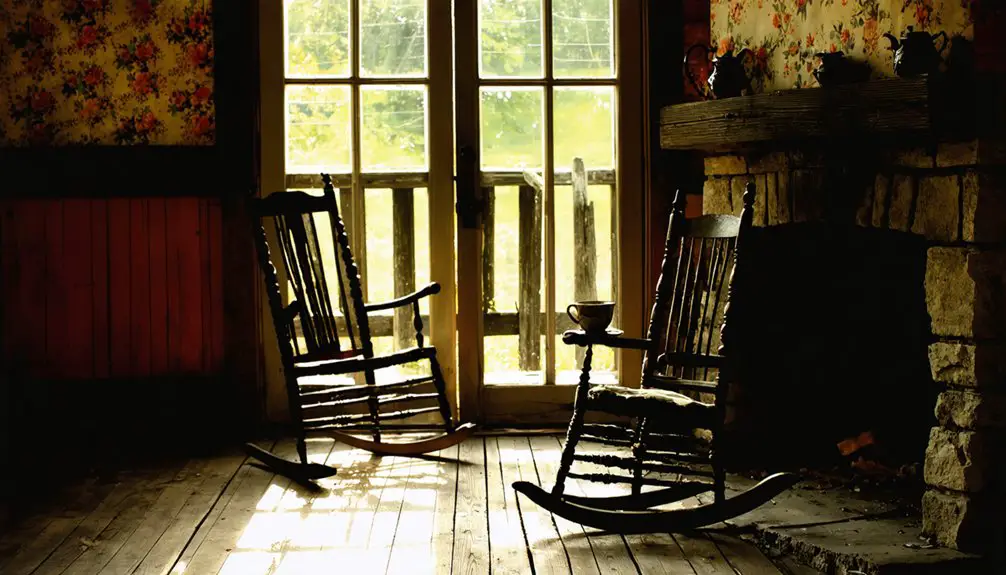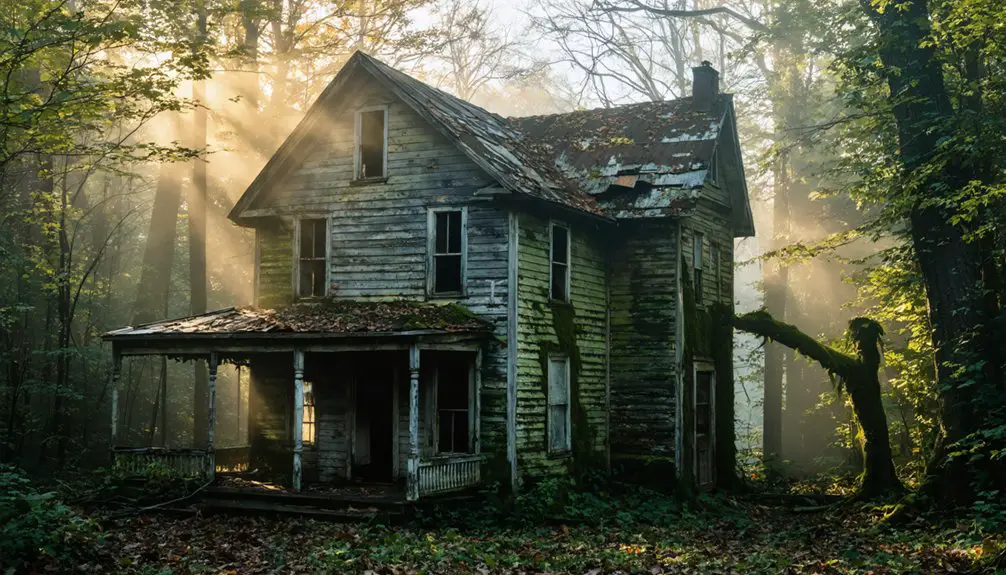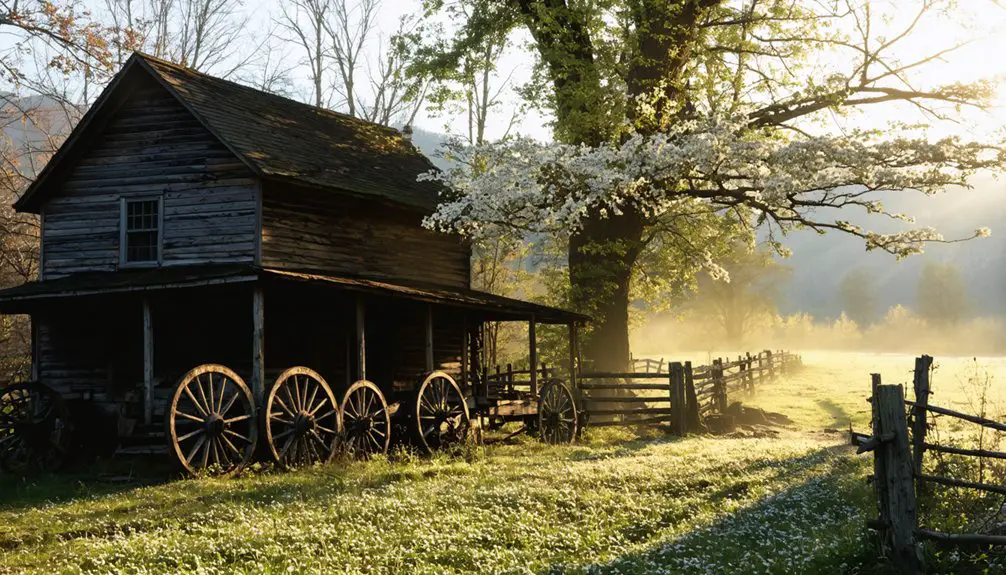You’ll discover the haunting remains of Elkmont Ghost Town within Tennessee’s Great Smoky Mountains National Park, where a once-thriving logging community transformed into an exclusive resort destination in the early 1900s. The abandoned settlement features 16 preserved historic structures, including the restored Appalachian Clubhouse and pioneer cabins. From its humble beginnings to its final days as a lease-held community in 1992, Elkmont’s rich history whispers through its weathered walls and ancient stone chimneys.
Key Takeaways
- Elkmont Ghost Town is a former logging community and resort area within Great Smoky Mountains National Park, featuring 16 preserved historic buildings.
- The site transitioned from a thriving logging town to an exclusive resort destination in the early 1900s before becoming abandoned.
- Restoration efforts began in 2009 with a $9 million endowment to preserve historic structures and cultural heritage landmarks.
- Visitors can explore preserved cabins, the Appalachian Clubhouse, and remnant stone walls along hiking trails with interpretive signage.
- The last residents left in 1992 when their leases expired, turning the once-vibrant community into today’s ghost town attraction.
The Humble Beginnings of Little River Valley
While the Little River Valley remained largely untamed in the 1800s, its rich resources attracted a diverse mix of early settlers who shaped the area’s initial development.
The pristine Little River Valley beckoned to pioneering settlers, drawn by the promise of abundant natural wealth in untouched wilderness.
You’ll find that homesteaders, hunters, squatters, and small-scale loggers were among the first to recognize the valley’s potential.
The land’s ownership history began with Robert Trentham, whose son Levi inherited the property in 1905.
After having the land surveyed, Levi sold parcels to wealthy hunters and industrialist W.B. Townsend.
This led to Townsend’s acquisition of 80,000 acres, which he incorporated into the Little River Lumber Company.
The area quickly transformed into a logging camp, complete with shanties, a post office, commissary, and railroad maintenance facilities – marking the beginning of Elkmont’s industrial era.
The company’s logging operations were extensive, harvesting an impressive 560 million board feet of lumber from the Great Smoky Mountains over four decades.
To avoid confusion with other locations, the area became known as Elkmont, Tennessee to distinguish it from similar place names across the country.
Rise of the Logging Empire
As the 19th century drew to a close, commercial logging operations descended upon Elkmont’s ancient forests, targeting valuable timber for construction, shipbuilding, tanning, and paper production.
You’ll find that Colonel Wilson B. Townsend‘s Little River Lumber Company dominated the industry after its establishment in 1901, purchasing over 80,000 acres of pristine forestland.
The company’s logging techniques revolutionized timber transportation through innovative solutions like the swinging railroad bridge at Meigs Creek and steam-powered log-loaders. The Sary Parker engine required special block and tackle systems to traverse the bridge safely.
Workers lived in company towns, spending six-day workweeks dragging logs down wooden skidding roads with mules. The company constructed 150 miles of train track through the rugged mountain terrain.
By 1939, they’d harvested an astounding 560 million board feet of lumber.
While this brought economic prosperity to the region, it also left behind clear-cut landscapes and significant ecological damage that would forever change Elkmont’s character.
From Lumber to Tourism: A Town’s Evolution
The Little River Lumber Company’s innovative spirit extended beyond logging when they attached an observation car to their timber trains in 1909, offering tourists a scenic $1.95 ride from Knoxville to Elkmont.
This marked the beginning of Elkmont’s tourism evolution, as the company strategically sold land to exclusive social clubs. The economic transformation accelerated when the Appalachian Club and Wonderland Club developed high-end resorts, turning the lumber town into a sought-after vacation destination. In 1934, Colonel David Chapman led efforts to establish the Great Smoky Mountains National Park, forever changing Elkmont’s destiny. When logging operations finally ceased in 1926, the town’s identity had already shifted firmly toward recreation and tourism.
Key aspects of Elkmont’s transformation:
- Wealthy visitors replaced loggers as the primary residents, establishing summer homes and social gatherings
- Resort amenities expanded to include hotels, swimming holes, and recreational facilities
- By 1920, tourism had completely overtaken logging as the economic driver, setting the stage for national park development
The Birth of Great Smoky Mountains National Park
As you explore Elkmont’s history, you’ll discover that establishing the Great Smoky Mountains National Park required an unprecedented land acquisition effort, with hundreds of private properties being purchased from farmers, homesteaders, and timber companies between 1926 and 1939.
The park’s creation faced unique challenges since, unlike western parks carved from public lands, every acre had to be bought from private owners who’d built lives and livelihoods in these mountains.
This immense undertaking would ultimately protect 522,419 acres of diverse landscape, making it one of the largest protected areas in the eastern United States.
The ambitious vision began when Willis P. Davis first proposed the idea of creating a national park in the Smokies after visiting western parks in 1923.
North Carolina and Tennessee’s commitment of $2 million each, combined with the Rockefeller Foundation’s matching funds, finally enabled the massive land purchase campaign that would transform this region into America’s most visited national park.
Land Acquisition Challenges
Creating Great Smoky Mountains National Park required overcoming significant land acquisition hurdles between 1925 and 1936.
You’ll find that landowner resistance and timber company negotiations presented formidable challenges, as over 6,000 individual property owners and major corporations had to be convinced or compelled to sell their land.
The process began with the purchase of 76,507 acres from Little River Lumber Company, though timber rights remained with the seller for 15 years.
- John D. Rockefeller Jr.’s $5 million donation strengthened the government’s negotiating position against resistant timber companies.
- State governments used eminent domain to acquire properties from reluctant sellers, including over 1,100 small farms.
- Champion Fibre Company’s holdout ended through condemnation suits and negotiations by 1931.
Preserving Wilderness Legacy
Following the complex land acquisition phase, Great Smoky Mountains National Park emerged through a remarkable preservation effort that began in the late 1890s.
You’ll find that organizations like the Great Smoky Mountains Conservation Association played a pivotal role, raising funds and garnering political support for wilderness preservation. The group’s early publicity campaign helped generate crucial national attention.
The park’s establishment in 1934 marked a turning point, as the Civilian Conservation Corps transformed the landscape with essential infrastructure. The park’s diverse ecosystem now protects over 1,500 flowering plant species.
While initial policies focused on removing human traces to create pristine wilderness, park managers later shifted their approach to embrace cultural heritage preservation.
Today, you can experience this balanced vision in restored areas like Cades Cove and Cataloochee Valley.
The park’s UNESCO World Heritage Site designation confirms its success in protecting both natural wonders and historical significance.
Legacy of the Life Lease Residents

You’ll find that the daily routines of Elkmont’s last lease residents were deeply woven into the fabric of this mountain community, where families gathered on wide porches and children played in the Little River.
The generational connections ran deep, with some families tracing their Elkmont roots back to the early settlers of the 1830s, while others descended from the wealthy Knoxville elite who established summer homes in the early 1900s.
These multi-generational ties created a unique social tapestry that blended pioneer heritage with vacation culture, until the final lease expirations in 1992 brought this era to an end.
Last Residents’ Daily Life
While the National Park Service acquired Elkmont in 1934, a unique group of residents continued their lives there through special life lease agreements that allowed them to stay until death or relocation.
Their daily routines reflected remarkable community resilience, as they adapted to life without modern conveniences in an increasingly isolated setting.
- You’d find residents maintaining aging cabins using limited resources, making repairs to extend their homes’ habitability despite ongoing deterioration.
- You’d observe them sourcing water from springs and rivers, while relying on wood stoves and generators for basic utilities.
- You’d witness a tight-knit community supporting each other through harsh weather, limited communication, and restricted access to essential services.
Daily tasks emphasized self-sufficiency, while leisure time centered on hiking, fishing, and informal gatherings with neighbors.
Generational Family Connections
The generational ties to Elkmont ran far deeper than the daily routines of its last residents.
You’ll find family heritage stretching back to the 1840s, when pioneers like the Ownbys first settled the Little River valley. Notable figures like Levi Trentham, known as “the prophet of the Smokies,” inherited and surveyed his family’s land in 1905, cementing these ancestral connections.
The shift from lifetime to 20-year leases in 1952 dramatically altered how families maintained their generational ties.
Many who’d chosen the half-price sale option with lifetime lease rights saw their family cottages pass down through generations until 1992. When the National Park Service ended all leases that year, it marked the conclusion of a multi-generational era where families had preserved their heritage through annual gatherings and shared memories.
Preserving History: Restoration and Conservation
Following years of deterioration after property leases expired in 1992, restoration efforts at Elkmont Ghost Town began in earnest during 2009. The National Park Service and Friends of the Smokies partnered to establish a $9 million endowment, focusing on preserving 19 of the roughly 60 historic structures that remained.
Elkmont Ghost Town’s revival came in 2009 when a $9 million endowment launched preservation of 19 historic structures from decay.
Restoration teams meticulously maintained the historical architecture while stabilizing these cultural heritage landmarks.
You’ll find these key preservation accomplishments:
- Original materials and historic paint colors were matched to guarantee authenticity
- Detailed carpentry work took up to three years per cabin to complete
- Stone walls and chimneys were preserved as markers of vanished structures
Today, you can explore these restored buildings through public tours and interpretive programs, experiencing firsthand the transformation of this former logging and resort community.
Exploring Elkmont’s Haunting Beauty Today
Nestled within the Great Smoky Mountains National Park, modern-day Elkmont Ghost Town invites visitors to explore its haunting blend of preserved history and natural beauty.
You’ll discover 16 preserved buildings, including historic cabins and the Levi Trentham cabin, each offering glimpses into early 20th-century life. The ghost town aesthetics come alive through remnant stone walls and chimneys along Jakes Creek and Little River trails.
As you wander the grounds, you’ll encounter historical narratives through interpretive signage and guided tours. The surrounding forest creates an immersive backdrop, where seasonal changes paint the landscape from misty mornings to vibrant autumn colors.
The Appalachian Clubhouse stands as a tribute to preservation efforts, while nearby hiking trails connect you to both cultural heritage and pristine wilderness, making Elkmont a uniquely atmospheric destination.
Frequently Asked Questions
Can Visitors Stay Overnight in Any of the Preserved Historic Buildings?
While you’d love to sleep where history meets moonlight, you can’t stay overnight in the preserved historic buildings. They’re maintained strictly for educational tours, not overnight accommodations – preserving heritage over hospitality.
Are There Reports of Paranormal Activity or Ghost Sightings in Elkmont?
You’ll find numerous ghost stories and local legends, with visitors reporting mysterious sounds, unexplained figures, and eerie sensations inside preserved buildings. Many claim to feel watched while exploring these historic structures.
What Is the Best Time of Year to See Synchronous Fireflies?
You’ll find synchronous fireflies at their peak during late May through early June, with the most spectacular seasonal patterns occurring in the first week of June when temperatures stay above 50°F at night.
How Long Does It Typically Take to Explore the Entire Ghost Town?
You’ll want to allow 2-3 hours for a complete exploration – spending about 1-2 hours examining the historic buildings and another hour walking trails to discover remnants like stone walls and chimneys.
Are There Guided Tours Available Through the Abandoned Structures and Buildings?
You can join Pink Adventure Tours’ guided exploration of the historic structures, offering expert commentary on their historical significance. While some buildings are off-limits, 16 restored structures remain accessible to you.
References
- https://www.visitmysmokies.com/blog/smoky-mountains/about-elkmont-ghost-town/
- https://hikinginthesmokymountains.com/blog/elkmont-ghost-town-restoration/
- https://gatlinburghaunts.com/elkmont-tennessees-ghost-town/
- https://elkmontstationknox.com/blog/history-elkmont-smoky-mountains/
- https://en.wikipedia.org/wiki/Elkmont
- https://www.patriotgetaways.com/blog/elkmont-ghost-town
- http://www.mysmokymountainvacation.com/elkmont-history.html
- https://www.visitmysmokies.com/blog/smoky-mountains/things-didnt-know-history-elkmont-ghost-town/
- https://smokieslife.org/2019/01/28/a-swinging-railroad-bridge-in-elkmont-i-had-no-idea/
- https://www.tnmagazine.org/before-the-national-park-large-parts-of-the-smokies-were-clear-cut/



